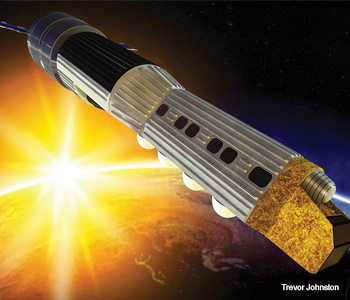
In 1965, U.S. Central Intelligence Agency (CIA) director John McCone posed a challenge to a select few American companies: Create a surveillance satellite that combines the best features of its predecessors—the broad area coverage of Corona and the high-resolution images of the KH-7 Gambit. Thus, the seed was planted for what would eventually become the KH-9 Hexagon spy satellite—the last film-based orbiting reconnaissance camera to be developed for the U.S. government.
The first of 20 Hexagon satellites launched into orbit on 15 June 1971. The satellites contained an elaborate system of cameras that took expansive, detailed photographs of the former Soviet Union, China and other countries deemed to pose a potential threat to the United States. Hexagon became an invaluable asset during the Cold War, providing intelligence credited with persuading U.S. President Richard Nixon to sign the 1972 Strategic Arms Limitation Treaty (SALT-1)—the most far-reaching attempt to control the proliferation of nuclear arms at that time.
I was involved with the Hexagon project from the earliest stages of its development to its launch. Thanks to the U.S. National Reconnaissance Office, which declassified Hexagon on 17 September 2011—nearly 25 years after its ill-fated 20th satellite mission—I can finally share my story.
A perfect pitch
In the early 1960s, I was one of a small group of employees at PerkinElmer Corporation charged with working on McCone’s CIA surveillance satellite challenge. After conducting a year of research, we pitched our ideas to the agency at night in an innocuous-looking safe house in Washington, D.C. Albert “Bud” Wheelon, the first CIA deputy director of science and technology, told us that the agency thought highly of our concept.
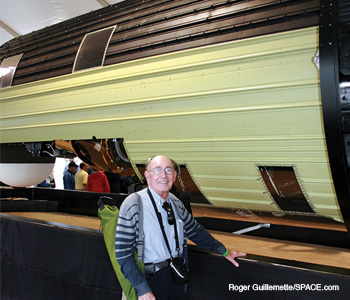 Pressel with the KH-9 Hexagon satellite.
Pressel with the KH-9 Hexagon satellite.
After our initial agency meeting, we spent an intense six weeks writing a formal engineering proposal for the project. It culminated in May 1966, when PerkinElmer CEO Chester Nimitz Jr., son of the famous World War II admiral, made an impassioned—and decidedly un-scientific—plea: At the end of our presentation to the CIA, he stood up, put his foot on the table and said, “We want this f-----g job and we’re gonna get every f-----g agency and every f-----g engineer from here to Florida. We recognize the importance to national security and we’re capable of doing the job.” It was a memorable event.
Four months later, on 10 October 1966, we were told to gather at 10 a.m. in the large engineering room at PerkinElmer—an isolated and secure area across the street from one of the two main plants. Group vice president Dick Werner, our program manager Mike Maguire and contract specialist Charley Hall walked in shortly afterwards. As they reached the front of the room, Dick reached into his jacket pocket and took out the longest cigar I had ever seen. The first words out of his mouth were “We won!”
The room erupted in a loud cheer. Dick and Mike each spoke a few words of praise for the great team effort and wished us success in this new adventure.
As soon as the meeting broke up, some of us went immediately to our desks and called our wives to tell them we had won a big contract that would keep us employed for a long time. (In those days, we had no female engineers or scientists to call their husbands; the women arrived much later.)
Some employees also called their brokers to buy as much PerkinElmer stock as they could afford. I could not afford much, but I purchased a small number of shares. The next day a secretary went around asking everyone if they had purchased company shares and, if so, how many. This list was given to our legal department.
All of us expected to be reprimanded for insider trading and possibly made to sell the shares or void our purchases. However, we heard nothing from legal. I assume the total number of shares we bought was not considered significant. But it turned out to be a lucrative investment for many of us, especially for those who had the courage to invest “serious” funds. PerkinElmer stock split seven times in the next 12 years.
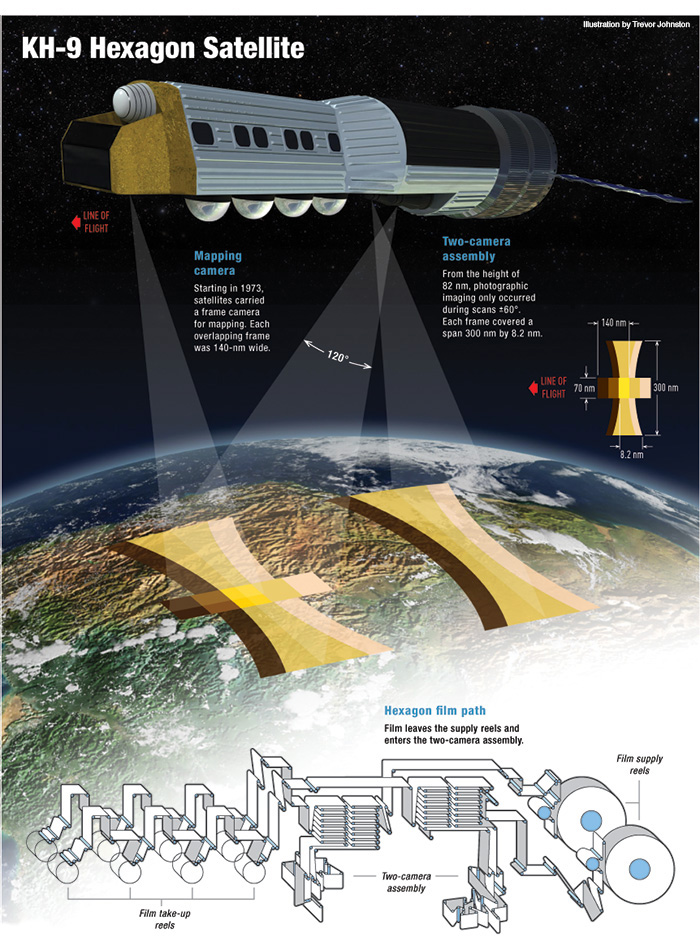 |
Security screening and paperwork
It was difficult for PerkinElmer to hire a skilled technical staff because the satellite program was top secret. We could not tell potential candidates the nature of the program or the specific tasks to which they would be assigned. In addition, completing the required background and security checks took anywhere from four months to a year. Permanent employment was dependent on clearing the security screening.
New hires were told not to discuss or even speculate about the nature of the program. While awaiting their clearances, most worked on unclassified jobs in a non-secure part of the building that we called “the tank.” It was also jokingly referred to as “the mushroom patch” because the people working there were kept in the dark and fed a lot of crap.
Everyone in the tank eagerly awaited their clearance. Dick Carrito, a systems and servomechanism engineer, recalls being summoned to the security office after his paperwork was cleared:
“I was given a bunch of documents to read and sign. I remember being awed by the words I was reading. It seemed like I was being told more than I needed to know. After 40 years, my memory is a little hazy, but I do remember something like: … a study program leading to the design and development of a photo reconnaissance satellite, to conduct covert operations for the CIA, under cover as the Discoverer Program. This high-resolution system is to carry out search and surveillance missions over the Sino-Soviet Bloc … the program name is FULCRUM.” (The name was later changed to Hexagon.)
As Carrito recalls, the documents droned on about not revealing, acknowledging or commenting on the existence of the program, the program name, the customer’s name or any of the participants in the program. This discussion ban included everyone, from the engineers’ family and friends all the way to other members of the program who had the proper security clearance but lacked an explicit need to know.
When Carrito had finished all the reading and signing, the security officer asked him if he was surprised. “I didn’t have a feeling of surprise; I felt numb,” he said. “I had just read a lot of words and concepts that I had never considered before: covert operations, under cover, search and surveillance of the Sino-Soviet Bloc, and compartmentalized security clearances ... I had a lot to learn! No, I didn’t feel surprised, I felt like I had just joined the Big Leagues.”
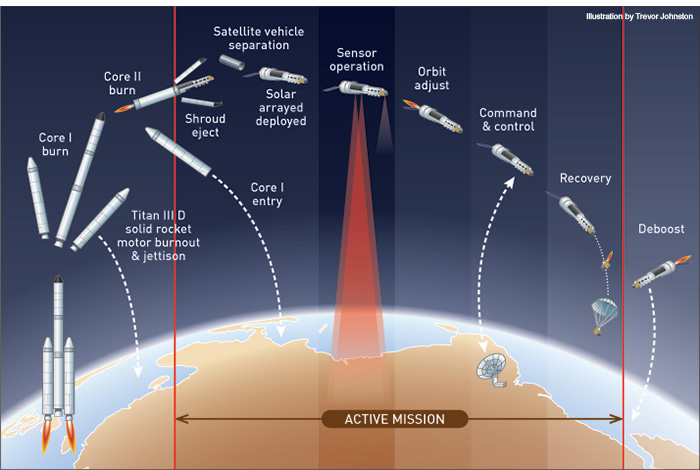 KH-9 Hexagon satellite: Launch, operation and film recovery (1971–1986). The KH-9 Hexagon satellite was launched via a Titan IIID rocket. After completing its mission, KH-9 would release one of four reentry vehicles containing photographic film. Equipped with its own parachute, the vehicle would float down until it was picked up mid-air by a military transport aircraft. KH-9 Hexagon satellite: Launch, operation and film recovery (1971–1986). The KH-9 Hexagon satellite was launched via a Titan IIID rocket. After completing its mission, KH-9 would release one of four reentry vehicles containing photographic film. Equipped with its own parachute, the vehicle would float down until it was picked up mid-air by a military transport aircraft. |
Getting down to business
The design process in the late 1960s was very different from what it is today. Computers were large, general-purpose mainframes that received input on punched cards and produced output on magnetic tape or an impact printer. We were limited to early versions of analysis programs such as NASTRAN (for mechanical structural analysis) and SINDA (for thermal analysis).
We drew our designs for the Hexagon project by hand on drafting boards with pencils, not with computer-aided design systems. Major changes required a lot of erasing or starting over from scratch. Large machines that used ammonia and other chemicals copied these drawings to make actual “blueprints.” The chemical smell permeated the blueprinting department, and copies retained the odor for quite a while.
We had no graphic printers or displays, and we could not rotate our drawings on a screen or look at parts in 3-D. Most of our engineers did math on slide rules or desktop calculators; pocket electronic calculators did not arrive until the early 1970s. By modern standards, the tools we used were antiques.
The satellite was about the size of a school bus. It weighed 30,000 pounds, and it was 60 feet long and 10 feet in diameter. Each of the two cameras carried 30 miles of film. The cameras, called optical bars, were f/3-folded Wright optical systems with a focal length of 60 in. The optical bars were identical and contained an entrance window, a fold-flat mirror, a 26-in. primary mirror and a field group of lenses.
The mirrors were four inches thick and made of two faceplates fused to a hollowed-out core. We polished them to an rms wavefront quality of 1/50th of a wave. Images captured by the camera were imposed on the focal plane located one inch in back of the last lens. One optical bar was tilted 10 degrees to look forward, and the other 10 degrees to look back, creating a 20-degree stereo angle.
To compensate for momentum, the optical bars rotated continuously in opposite directions during photography, as did many other components of the satellite. They rotated at a constant speed depending on V/h (the orbital velocity divided by the altitude above Earth). Photographic imaging occurred only during scans of ± 60 degrees or less on either side of nadir (looking straight down). During photographic scans, the film’s linear velocity and rotational speed (also a function of V/h) in the platen (a mechanism that controlled film speed and synchronization with the image at the focal plane) had to be carefully synchronized with the moving image.
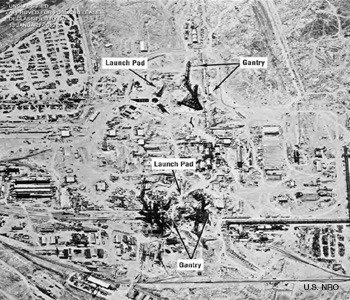 Hexagon satellite panoramic camera image of Tyuratam missle test range in the former Soviet Union, August 1984.
Hexagon satellite panoramic camera image of Tyuratam missle test range in the former Soviet Union, August 1984.
Film exited the supply reels at a constant velocity of 70 in./s. After the film left the supply, it needed to move in accordance with a prescribed film velocity profile to enable photographs to be captured at the proper time and to use as much of the film as possible. The film traveled over many rollers along a 100-foot path and was accelerated to photographic speed in the platen.
At perigee (the lowest point in the satellite’s orbit), the film speed was 204 in./s. After exposure, the film decelerated and travelled backwards so that the next exposure occurred only two inches away. The film was then stopped so that an electronic data block could be inscribed on it in this narrow space. At altitudes higher than perigee, the film and camera rotational speeds slowed down proportionately.
The oscillating portion of the platen was synchronized to the rotating segment of the optical bar. The key to the success of the camera system was the invention of the twister. This relatively simple device consisted of a few rollers and two pivoted air bars (D-shaped cylinders through which dry nitrogen passed, enabling the film to ride on a protective air gap). The twister was a self-aligning, passive device that allowed the film to be rotated in synchronization with the optical bar during photography.
The looper, a film storage device, accommodated the film velocity profile from constant low velocity at the supply to variable high speed at the focal plane in the platen. It also stored film during the non-photographic cycle (240 degrees or more) of the optical bar. The looper contained a carriage and many rollers. The carriage traveled linearly back and forth. In one direction, it drew the proper quantity of film from the supply reels into the entrance side of the looper while simultaneously feeding film into the platen for exposure.
After exposure, the film moved in reverse and was stored in the exit side of the looper. It was wound up at a constant speed of 70 in./s. onto the take-up assembly in the forward section of the Hexagon. After the first take-up reel (each in its own re-entry vehicle) was filled, the film was wound and cinched onto the core of the next reel and then cut. During one of the next orbits, the exposed film was jettisoned to Earth in a re-entry vehicle and caught by a military C-130 Hercules aircraft over the Pacific.
3, 2, 1 …
It took almost five years of development and testing to reach our launch date—15 June 1971. I sat next to Mike Maguire and several others in our war room. We listened to the Vandenberg Air Force Base launch controller countdown to ignition and liftoff of a Titan IIID rocket with about 3 million pounds of thrust. It housed the first Hexagon satellite. We received periodic updates on altitude and speed interspersed with long stretches of silence. Eventually the controller confirmed that the payload had reached orbit; it would be the first of 19 successful launches.
The Hexagon surveillance satellite was a marvel of engineering. It was a fine optical instrument capable of taking stereo photographs of the entire Earth as well as images so clear that you could distinguish between objects two to three feet in size from an altitude of 90 miles above the Earth.
End of an era
The date 18 April 1986 will always be etched in my memory. For the last time, we heard the countdown. A noisy and powerful exhaust came from the rocket as it rose off the pad at Vandenberg. Then, disaster struck. The rocket exploded in a fiery blast before it reached 1,000 feet, destroying the 20th and last Hexagon. Fortunately, unlike with the tragic Challenger explosion that had occurred just a few months earlier, there was no loss of human life.
Known to the public as “Big Bird,” Hexagon succeeded beyond any of our dreams. The program helped to ease Cold War tensions and became the most successful film-based spy satellite ever to be used by the United States. At the declassification ceremony in September 2011, my wife and I had the privilege of joining several former colleagues and sharing our memories. At last, our secret was out.
This article was excerpted from Phil Pressel’s contribution to OSA’s Centennial history book, which is currently under development, with additional editorial support from science writer Jeff Hecht.
Phil Pressel retired after 30 years with PerkinElmer. He was the project engineer in charge of designing Hexagon’s cameras and other classified optical instruments for the government. He now lives in San Diego, where he consults for Quartus Engineering Incorporated.
To learn more …
You can read more about Phil Pressel’s recollections about the Hexagon project in his new book, Meeting the Challenge: The Hexagon KH-9 Reconnaissance Satellite, which is available through the American Institute of Aeronautics and Astronautics (2013): http://arc.aiaa.org/doi/book/10.2514/4.102035
